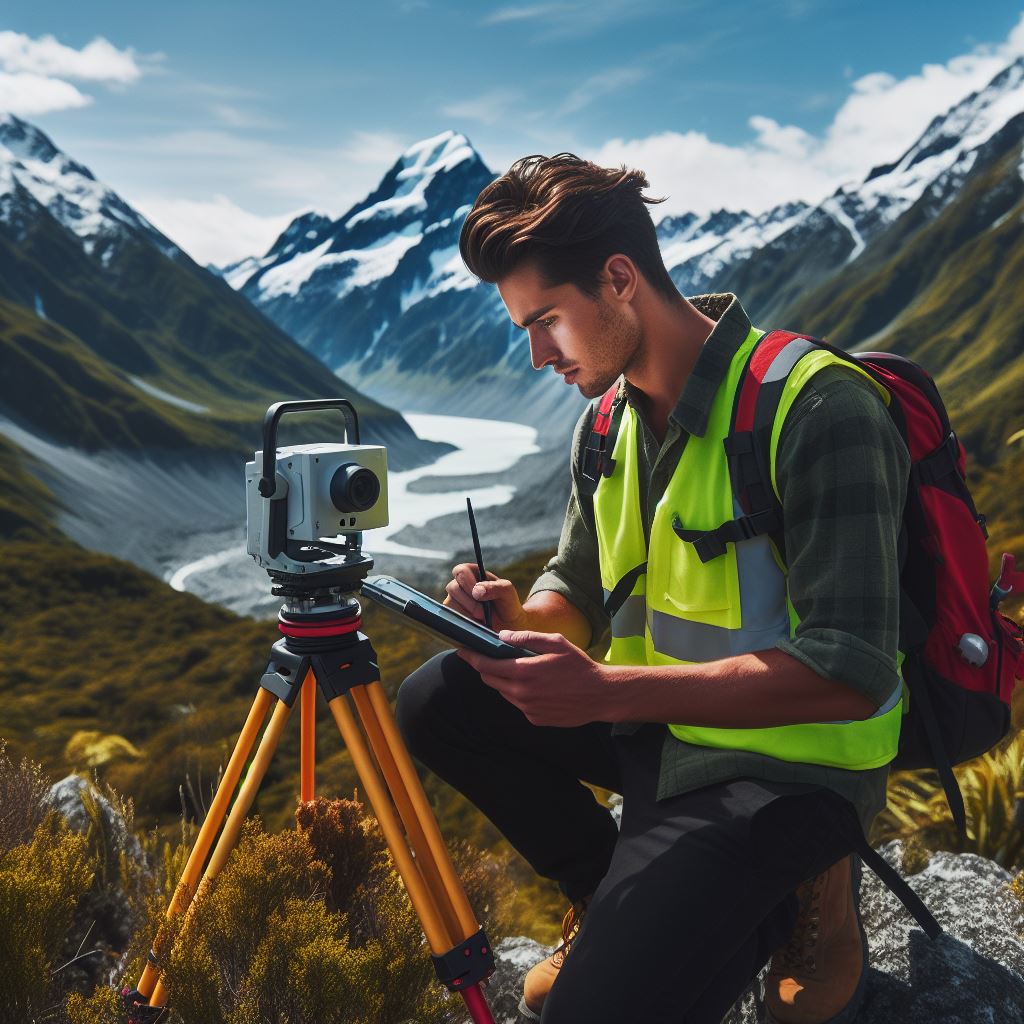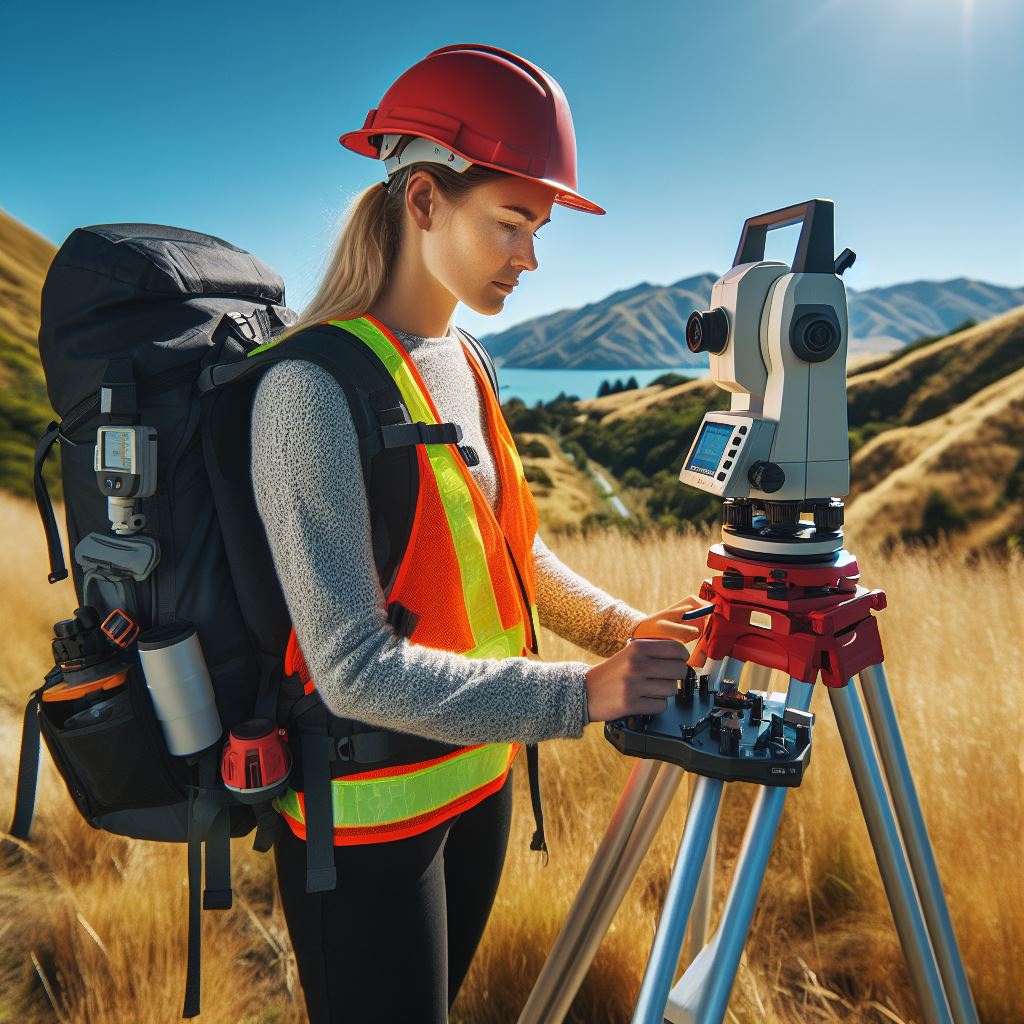Introduction
Being a land surveyor in New Zealand involves various tasks, challenges, and adventures throughout the workday.
They utilize cutting-edge technology and traverse rugged terrain for precise measurements. Each day brings new projects and client interactions. Surveyors review project plans, gather equipment, and head to the field.
Fieldwork includes traversing remote locations and using specialized tools. They establish control points and collect field data.
Surveyors navigate legal frameworks, property boundaries, and environmental considerations. Interactions require effective communication and problem-solving skills.
Weather conditions and terrain obstacles test their adaptability. Surveyors find fulfillment in contributing to infrastructure projects. Their expertise ensures the integrity of property boundaries and cadastral records.
They also play a critical role in disaster response and environmental conservation. Technology advancements enhance efficiency, accuracy, and safety in surveying operations.
Surveyors document field observations and update project records digitally. They process data, analyze findings, and collaborate with engineers.
The day concludes with reflection and preparation for the next tasks. This section explores the dynamic world of Kiwi land surveyors.
We delve into their daily routines and contributions to New Zealand’s built environment. Join us on a journey through the life of a land surveyor in Aotearoa.
Qualifications and Training
Educational Requirements
- Obtaining a bachelor’s degree in surveying or a related field is the first step.
- This degree must be accredited by the New Zealand Institute of Surveyors (NZIS).
- Majoring in surveying, geospatial science, or cadastral surveying is typically required.
- Completing courses in mathematics, physics, geography, and computer science is also beneficial.
- Some universities offer postgraduate programs for those who want to further specialize in surveying.
Certifications and Licenses
- After completing a relevant degree, aspiring land surveyors need to register with the New Zealand Institute of Surveyors (NZIS).
- The NZIS offers various types of memberships and certifications based on level of experience and expertise.
- Obtaining a license from the New Zealand Licensed Cadastral Surveyors Board is also required.
- This license allows surveyors to conduct cadastral surveying, which involves determining property boundaries and subdivisions.
Training Process
- Upon completion of the necessary education and licensure, new land surveyors typically start as assistants.
- They work under the guidance and supervision of experienced surveyors to gain practical skills and knowledge.
- During this training period, surveyors learn how to operate surveying equipment and use relevant software.
- They also develop the ability to interpret maps and other spatial data accurately.
- As they gain experience and demonstrate competence, surveyors can progress to more independent roles.
Potential Career Progression
- With experience and continuing education, land surveyors can become senior or principal surveyors in their field.
- They can specialize in areas such as engineering surveying, hydrographic surveying, or cadastral surveying.
- Surveyors who seek advanced roles may pursue a master’s degree or a PhD in surveying or a related field.
- Some surveyors may choose to become self-employed and establish their own surveying firms.
- There are also opportunities to work internationally, especially in countries with similar surveying practices.
In review, to become a land surveyor in New Zealand, individuals need to complete a bachelor’s degree in surveying or a related field.
Accreditation by the NZIS is essential, and majoring in certain areas is typically required. Registration with the NZIS and obtaining a license from the Licensed Cadastral Surveyors Board are also necessary.
After completing the necessary education and licensure, aspiring surveyors start as assistants and progress to more independent roles with gained experience.
They can also specialize in different surveying areas and pursue advanced degrees. Career progression may lead to senior roles, self-employment, or international opportunities.
Read: Emerging Tech Trends in NZ’s Electrical Field
Overview of Job Duties
Being a land surveyor requires a diverse range of tasks that need to be accomplished daily. Let’s delve into the typical day in the life of a Kiwi land surveyor.
Day-to-day tasks
- Conducting field surveys to gather data on land boundaries, topography, and existing structures.
- Preparing and maintaining sketches, maps, and reports based on survey results.
- Using specialized equipment such as total stations, GPS, and laser scanners to measure distances and angles accurately.
- Collaborating with engineers, architects, and construction teams to determine project requirements.
- Reviewing land records and legal documents to obtain information needed for surveys.
- Analyzing survey data to establish property lines, elevations, and contours.
- Identifying potential issues or discrepancies in property boundaries and resolving them.
- Providing expert testimony in court cases related to land surveying.
Specialized equipment and software
Land surveyors heavily rely on the use of specialized tools and software to carry out their tasks efficiently and accurately.
- Total Stations: These sophisticated optical instruments combine the functions of theodolites and electronic distance meters, enabling precise angle and distance measurements.
- Global Positioning System (GPS): Land surveyors use GPS receivers to determine their precise location on the Earth’s surface, allowing for accurate mapping and positioning.
- Laser Scanners: This advanced technology generates detailed 3D models of existing structures and terrains, making it easier to identify potential challenges or plan modifications.
- Computer-Aided Design (CAD) Software: Land surveyors utilize CAD software to process and interpret survey data, create detailed maps, and generate reports.
- Geographic Information Systems (GIS): GIS software helps land surveyors analyze spatial data, visualize survey results, and integrate them with other relevant datasets.
The importance of accuracy and attention to detail
Accuracy and attention to detail are crucial aspects of land surveying. Here’s why they matter:
- Boundary Determination: Land surveyors must accurately establish property boundaries to avoid potential legal disputes.
- Construction Projects: Precise measurements and data collection are essential for successful planning and execution of construction projects.
- Land Development: Accurate mapping of topography and existing structures assists in land development planning, such as building subdivisions or infrastructure.
- Environmental Impact Assessment: Detailed surveys aid in assessing the environmental impact of projects, ensuring compliance with regulations.
- Public Safety: Accurate mapping of existing structures helps prevent accidents, ensuring public safety.
Generally, a day in the life of a Kiwi land surveyor is filled with diverse tasks that require the use of specialized equipment and software.
Accuracy and attention to detail remain vital as they contribute to the success and reliability of land surveys.
Read: Salary Guide: Electrical Engineers in NZ
Starting the Day
A typical day for a land surveyor begins with a routine that helps them prepare for the tasks ahead. Here’s what a morning usually looks like:
- Wake up early, often before sunrise, to take advantage of the daylight and avoid traffic.
- Get dressed in comfortable and durable clothing, including work boots, a hat, safety vest, and gloves.
- Have a healthy breakfast to fuel the body for the physically demanding work ahead.
- Review the surveying plans and maps for the day’s assignments.
- Check and organize the necessary equipment and tools, ensuring everything is in proper working order.
- Load the surveying vehicle with the required equipment, including a theodolite, total station, GPS device, and other tools.
- Perform a thorough safety check on the vehicle, including checking the tires, brakes, lights, and emergency equipment.
- Create a daily checklist to ensure all safety precautions are met, such as wearing reflective clothing, harnesses, and hard hats.
- Prepare the necessary documents, such as permits and licenses, that may be required for specific surveying locations.
- Communicate with the surveying team to ensure everyone is aware of the day’s tasks and any changes or updates.
Pre-planning and equipment checks are crucial for a land surveyor to ensure a smooth and efficient workflow. Without proper preparation, delays and safety risks could jeopardize the success of the day’s work.
Importance of Safety Precautions
As a land surveyor, safety is of paramount importance due to the nature of the job. Here are some key reasons why safety precautions cannot be overlooked:
- Protection from Accidents: Surveying often takes place in challenging terrains, including construction sites and remote areas. Adhering to safety measures reduces the risk of accidents and injuries.
- Minimizing Liability: By implementing safety protocols, surveyors protect themselves and their employers from potential lawsuits resulting from on-site accidents.
- Maintaining Professional Standards: Demonstrating a commitment to safety reflects professionalism and dedication to the field, fostering trust with clients and colleagues.
- Preserving Data Integrity: Accurate surveying requires concentration. Safety precautions ensure that surveyors can focus on their work without unnecessary distractions or hazards.
- Protecting the Environment: Surveyors must consider the environmental impact of their work and take precautions to minimize damage to flora and fauna.
In general, a land surveyor’s morning routine involves careful preparation, including equipment checks, safety precautions, and communication with the team.
By starting the day methodically and prioritizing safety, surveyors can ensure the accuracy and efficiency of their work.
Read: Women in Electrical Engineering in NZ

Field Work
As a land surveyor, conducting fieldwork is an essential part of my job. It involves several steps:
- Planning: Before heading out to the field, I carefully plan the survey based on the project requirements and client’s needs.
- Research: I gather all relevant documents, maps, and historical data related to the survey area.
- Evaluating equipment: I check and calibrate my surveying equipment to ensure accurate measurements.
- Scouting the location: I visit the site to get familiar with the terrain, landmarks, and potential challenges.
- Setting control points: I establish reference points to precisely position and align my surveying instruments.
- Taking measurements: Using various techniques and instruments like GPS receivers, total stations, or levels, I measure distances, angles, and elevations.
- Cross-referencing: To ensure accuracy, I cross-check measurements and repeat observations multiple times.
- Recording data: I carefully record all data, measurements, and observations in my field notebook or electronic device.
- Problem-solving: Sometimes, unexpected obstacles or complications arise while conducting fieldwork. In such cases, I use my expertise to find practical solutions.
- Finalizing fieldwork: Once all necessary measurements are complete, I wrap up the fieldwork and prepare for data processing.
There are different types of surveys and measurements taken during fieldwork
- Topographic surveys: These determine the shape, features, and relief of the land, including natural and man-made features.
- Boundary surveys: These establish the legal boundaries of a property, preventing encroachments and disputes.
- Construction surveys: These provide precise measurements and layouts for building infrastructure.
- As-built surveys: These document the exact locations and dimensions of constructed features or structures.
- Control surveys: These establish reference points that will be used as a framework for future surveys in the area.
Despite meticulous planning, challenges and obstacles can arise in the field
- Unfavorable weather conditions like rain, snow, or extreme temperatures can affect equipment and limit visibility.
- Difficult terrains such as dense forests, steep slopes, or water bodies can make access and measurements challenging.
- Obstructions like vegetation, buildings, or fences can obstruct line of sight and require innovative solutions.
- Encountering wildlife or dealing with landowners or residents who are unaware of the survey can cause delays or interruptions.
- Unpredictable survey site conditions like underground utilities or unstable ground can pose safety risks and complicate measurements.
Despite these challenges, conducting fieldwork as a land surveyor is a rewarding experience.
It allows me to work outdoors, explore different landscapes, and contribute to the built environment with accurate measurements and data.
Personalized Career Consulting
Unlock your potential with expert career advice tailored to your goals. Get personalized guidance and actionable steps toward your dream career in New Zealand.
Get StartedRead: Interview: NZ Electrical Engineers’ Success Stories
Data Processing and Analysis
In order to make sense of the data collected during a land survey, a series of steps are undertaken to process and analyze the information.
These steps ensure accuracy and provide valuable insights for various applications. Additionally, specialized software and tools are utilized to streamline the process.
Steps Involved in Processing and Analyzing the Data
- Data Acquisition: The first step involves collecting data using state-of-the-art surveying equipment such as GPS receivers and total stations.
- Data Conversion: The raw data collected is then converted into a digital format, making it easier to manipulate and analyze.
- Data Editing: Any errors or outliers in the data are identified and corrected to ensure the accuracy of the final results.
- Data Reduction: Large amounts of data are often collected during a land survey. It is necessary to reduce the data to a manageable size for analysis.
- Data Integration: Different data sets gathered from various sources are integrated to create a comprehensive and unified picture of the surveyed area.
- Data Validation: The processed data is checked against existing records or known coordinates to ensure its reliability and validity.
- Data Analysis: Statistical techniques are applied to the processed data to identify patterns, trends, and relationships within the surveyed area.
- Data Visualization: The analyzed data is then presented visually through maps, charts, and graphs to help stakeholders understand the survey results.
Use of Specialized Software and Tools
To facilitate the data processing and analysis, land surveyors rely on specialized software and tools designed specifically for their field. These tools automate various tasks, speed up the process, and enhance accuracy.
- Geographic Information System (GIS) software: This software allows land surveyors to visualize, manage, and analyze geographic data efficiently.
- Remote Sensing Tools: These tools help surveyors gather valuable information about the surveyed area using satellite imagery or aerial photography.
- Data Processing Software: Software tools specifically designed for data processing and analysis provide capabilities for validation, integration, and statistical analysis.
- CAD Software: Computer-Aided Design software is often used to create detailed maps and drawings based on the processed survey data.
Importance of Accuracy and Quality Control in Data Analysis
Accurate and reliable data analysis is crucial for crucial decision-making processes in numerous industries. It ensures that the results obtained from a land survey are trustworthy and can be used with confidence.
Quality control measures, such as data validation and error correction, are implemented throughout the data analysis process.
This minimizes errors and ensures that the final results meet the required industry standards.
Moreover, accuracy in data analysis directly affects the outcomes of various projects and developments based on the land survey.
Misinterpretation or inaccuracies in the data can lead to costly errors, legal disputes, or even compromise public safety.
Essentially, the data processing and analysis phase of a land survey involves several essential steps, utilization of specialized software and tools, and a strong emphasis on accuracy and quality control.
This stage transforms raw data into meaningful information, enabling land surveyors to provide valuable insights for planning, construction, and decision-making purposes.
Record Keeping and Reporting
As a land surveyor, maintaining accurate records and generating comprehensive reports is an essential part of the job.
It ensures transparency and provides critical information for various stakeholders involved in land surveying projects.
Maintaining Records
- A land surveyor keeps meticulous records of all surveys conducted, including field measurements, photographs, and observations.
- These records serve as a reference for future projects, allowing surveyors to access historical data and compare measurements.
- Modern surveying technologies, such as GPS and GIS, have revolutionized record keeping by offering more precise and digital data collection methods.
- Surveyors organize records systematically to facilitate easy retrieval and ensure their long-term preservation.
Generating Reports
- After completing a land survey, the surveyor generates reports that summarize and present findings clearly and concisely.
- Reports may include detailed maps, diagrams, and written descriptions, providing a comprehensive overview of the surveyed land.
- Surveyors use specialized software to process collected data and create accurate and professional reports.
- These reports are crucial for clients, government agencies, and other stakeholders to make informed decisions regarding land usage and development.
Legal and Regulatory Requirements
- Land surveyors must comply with specific legal and regulatory requirements when it comes to record keeping.
- These requirements exist to ensure the integrity and accuracy of survey records, protecting the rights and interests of landowners.
- Many jurisdictions require surveyors to maintain records for a specified number of years, determined by local laws.
- Surveyors may need to provide these records as evidence in legal disputes or when dealing with property boundary disputes.
Importance of Clear and Concise Documentation
- Clear and concise documentation is essential for effective communication within the surveying industry.
- Well-documented records and reports allow surveyors to provide accurate information to their clients, colleagues, and other professionals.
- Clear documentation ensures that all parties involved have a common understanding of the survey results, reducing the chances of misunderstandings and disputes.
- Accurate documentation also plays a crucial role in maintaining the reputation and credibility of the land surveyor.
- Well-documented surveys establish professionalism, increasing acceptance as valid evidence in legal proceedings.
Overall, record keeping and reporting are integral components of a land surveyor’s responsibilities.
By maintaining accurate records and generating comprehensive reports, surveyors contribute to the integrity and transparency of land surveying projects, ensuring the smooth development and management of land resources.
Collaboration and Communication
In the world of land surveying, collaboration and communication are essential for success.
As a land surveyor, I constantly find myself working alongside other professionals from various fields to ensure accurate and efficient results.
Role of a Land Surveyor in Collaboration
Land surveyors often collaborate with architects, civil engineers, and construction teams. These collaborations begin at the early stages of a project and continue through its completion.
- I work closely with architects to understand the layout and design of a new building or development. This collaboration helps in determining land boundaries and ensuring the structure fits within legal constraints.
- Civil engineers rely on my surveys to plan and design infrastructure projects, such as roads, bridges, and utility systems. By collaborating, we can identify potential obstacles and find optimal solutions.
- During construction, I collaborate with the construction team to monitor progress and make necessary adjustments based on site conditions. This ensures that the project stays on track.
The Importance of Effective Communication Skills
Clear and concise communication is vital for a land surveyor to convey important information and collaborate effectively with stakeholders.
- I communicate with clients to understand their project goals and address any concerns or questions they may have. Maintaining open lines of communication ensures meeting their expectations.
- Effective communication with other professionals involved in a project helps prevent misunderstandings and ensures that everyone is on the same page.
- Throughout the day, I frequently communicate with team members to provide updates on progress, discuss challenges, and coordinate tasks. This promotes efficiency and keeps projects moving forward.
Interactions with Clients and Stakeholders
As a land surveyor, I often interact with clients and stakeholders to gather information and provide updates on survey progress.
- At the beginning of a project, I meet with clients to understand their specific requirements and objectives. This ensures that I can tailor my surveys to meet their needs.
- During field surveys, I may encounter stakeholders who have questions or concerns regarding the surveying activities. By addressing their inquiries, I can alleviate any anxieties and maintain positive relationships.
- Throughout the day, I provide regular updates to clients and stakeholders on the status of surveys and any significant findings. Open communication fosters trust and allows for making necessary adjustments.
In essence, collaboration and communication are integral aspects of a land surveyor’s daily routine.
By working alongside other professionals and maintaining effective communication with clients and stakeholders, I can ensure accurate, efficient, and successful surveying outcomes.
Transform Your Career with a Professional CV and Cover Letter
Stand out to employers with an ATS-optimized resume and tailored cover letter designed to match your dream role. Let us craft your job application materials for success!
Get StartedCareer Outlook and Opportunities
Land surveying is a thriving industry in New Zealand, offering a variety of job opportunities and promising career advancements.
Here is an overview of the current job market, potential specializations, and the impact of industry trends on the profession:
Current job market
- The job market for land surveyors in New Zealand is relatively stable and offers numerous employment prospects.
- With ongoing urbanization and infrastructure development, there is a consistent demand for qualified land surveyors.
- Both public and private sectors employ land surveyors, including government agencies, consulting firms, and construction companies.
- Land surveyors often work in teams, collaborating with engineers, architects, and other professionals.
Career advancements and specializations
- Experienced land surveyors have several avenues for career growth and advancement.
- Some surveyors specialize in specific areas, such as cadastral surveying, engineering surveying, or hydrographic surveying.
- A land surveyor can become a senior surveyor or project manager, responsible for leading teams and overseeing complex projects.
- Higher-level positions may involve strategic planning, business development, or consultancy roles.
Industry trends and changes
- Advancements in technology, such as GPS and laser scanning, have revolutionized the field of land surveying.
- The use of unmanned aerial vehicles (UAVs) for aerial mapping and surveying is becoming more prevalent.
- For visualization and analysis, professionals increasingly utilize 3D modeling and virtual reality.
- Land surveyors need to stay updated with the latest software and technology to remain competitive.
Ultimately, the career outlook for land surveyors in New Zealand is positive, with a steady job market and opportunities for specialization and career advancements.
As the industry embraces technological advancements, surveyors must adapt and expand their skills to stay relevant in a changing landscape.
Conclusion
Main points discussed in the blog post
In closing, being a land surveyor is a demanding yet fulfilling career. The role of a surveyor is crucial in identifying boundaries, assessing land values, and ensuring accurate land development.
Their responsibilities involve conducting surveys, collecting data, using advanced technology, and providing accurate measurements.
The significance of their role lies in maintaining proper land management, which affects land ownership, property development, and infrastructure projects.
Land surveyors play a vital part in society by contributing to the growth, sustainability, and prosperity of communities.
Significance of the role and responsibilities of a land surveyor
If you’re intrigued by the field, pursuing a career as a land surveyor can offer rewarding opportunities.
It allows individuals to work outdoors, explore various terrains, and engage in technical advancements. The profession requires attention to detail, problem-solving skills, and a passion for mapping and measurements.
With the increasing demand for land surveyors, there are ample job prospects and potential for career growth.
It is a field where you can contribute to meaningful projects, collaborate with diverse teams, and make a difference in shaping the environment.
Encourage who are interested in the field to pursue it as a career option
If you have an interest in land surveying, consider obtaining a degree in surveying or a related field. Connect with professionals in the industry to gain insights and seek mentorship.
Join professional organizations and attend conferences to stay updated on the latest developments.
Land surveying offers a challenging yet fulfilling career option for those who enjoy working with precision, technology, and making a positive impact.
So, if you have the curiosity and determination, embrace the exciting journey of becoming a land surveyor.




